Today a report came out from the UK government select committee on Science and Technology looking into the apparent lack of practical science work in schools that will create the next generation of scientists . It is heartening to see that the problem of a lack of practical science in schools has been identified. It is something that I have spoken about and also heard many others publicly express concern over.
It is a little concerning that some of the reporting is suggesting that it is the teachers in schools avoiding doing field trips and hands on science due to health and safety concerns and to curriculum pressure as if it was the teachers that created the league tables, measurement culture and paperwork. Most teachers want to excite and engage students, that is the point of the vocation. It is the policies around schools, the funding models and the generic nature of the curriculum that is the problem.
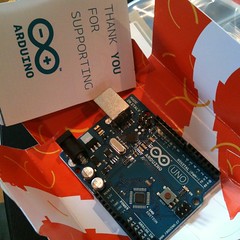
In the branch of technology that I work in there are plenty of opportunities for hands on practical work, programming, electronics, art, expression, logic etc. Much of what I try and help people with is things that they can just go and do, at relatively low of zero cost. That clearly can’t happen with some of the more physical sciences that require raw materials, or complex instruments but it is all about people getting to do and then share that creates interest. Being told and then measured really is not a sensible approach to inspire people of any generation.
As I wrote a few months ago about the excellent Raspberry PI project “There is also that realisation that developer community is shrinking, the grand masters are getting older, kids are not getting into programming. It’s not really even being taught.”
Whether you regard this as a science or an art or a branch of engineering the skills used in software development and understanding patterns of technology are relatively low cost to engage students with though it does need teachers who are programmers. I think there are few technical experts out there that want to change profession to teach ICT (which is basic use of of packages akin to learning to type). When I started as a programmer our teacher was from the industry, there were some keen hobbyist teachers too, but the main teacher has worked building systems. This, along with self teaching on easily accessible systems, was my grounding when I was in my early teens.
Now we have lots of unusual platforms, Opensim as a virtual world, Minecraft, Little Big Planet, Arduino hardware all available to encourage a generation of hackers, engineers and potential scientists just waiting to be rolled into more common school usage.
What am I doing about that then? Well short of going to train to be a teacher (now there is an idea!) I try and bring these things to the TV and to presentation and conferences, trying to show through practically doing things.
Of course if we miss a generation or two, separating them from technology and science in favour of paperwork we end up with a set of parents who will not be able to share the science with their kids. This in turn will lead to politicians, teachers and educators that also do not have that passion for science and tech. So we have no choice.
I know I gained an appreciation of large scale engineering and the challenges of it from my Dad working building ships. The trades (welding, plating, carpentry, technical drawing and design etc) all blended together into a very tangible and physical experience of what has to come together to make something as impressive as a large ship.
We need to make sure that whilst all the red tape and obsessive measuring is removed from education we keep the interest levels alive so that when the system is ready to enthuse the kids they haven’t given up already.
business
Develop Brighton 2011 – featuring Virtual Worlds
I just got the great news that my application to present at the Evolve portion of this years Develop conference has been accepted. It will of course be an elective session. Having attended Develop the last couple of years, and really enjoyed the sessions I felt that the virtual world industry and the crossover into social media was missing. So this year I thought I would throw my hat in the ring and do a version of washing away cave paintings.

Evolve is a part of the conference on day 1 that is about emerging trends and tech. Michael Acton Smith of Moshi is keynoting the day too 🙂
I submitted this as my talk.
EVOLVE: So You Think Virtual Worlds Aren’t Important?
Session Details
User generated virtual worlds may seem a sideshow. Open source development is making inroads, with Opensim, into fully user generated environments hosted anywhere run by anyone. These are used for entertainment and in training medical staff or school education.
They are an innovative platform for the next wave of designers and programmers. We have shown, on the kids ITV show The Cool Stuff Collective, these virtual worlds are growing to be a distribution platform for goods that will not remain solely as digital properties. Virtual things are getting real. Come and pay attention to virtual worlds and the future.
Wish me luck and maybe see you there (early bird registration finishes june 15th )
Everybody is freelance? Saves the economy?
When I started my career in corporate life back in 1990 there seemed to be quite an obvious path to take. You got a job, with an employer, where there was a implied long term agreement. Not always suggesting a job for life, but it in general that seemed to be what people did.
During the following few years I watched as we increasingly hired in contractors, but generally on a relatively long term. Tech companies tended to need to do that with programmers to build a particularly large piece of software with a known end date. Those that “went contracting” seemed to have a very lucrative time, but traded off the apparent security of a permanent staff job. Very often the staff job was considered a role, not a mini contract.
I am not sure when it happened, but very soon it seemed that everyone became a freelancer insider the company structure, vying for work competing to be on the right customer contract. CV’s and bio’s and personal recommendations flying around all over the place.
In a corporate environment this labour market economy always seemed slightly at odds with what the purpose of belonging to a such an entity. Competing for work with colleagues but only in the bounds of the contracts that the company is trying to win or work seems counter productive.
Now that I am effectively freelance, though employed by my own company Feeding Edge I am getting to see and feel the proper potential of the individual vying for work, and the even more incredible power of self organising groups of people in similar positions. These affiliations can be transient, but they can also be incredible bonding experiences with mutual trust and support.
I have been observing and appreciating this from both my more regular tech company relationships and from being thrown into the media and TV industry.

People are not all M&M’s from the same packet, but in different colour clothes. There i smuch more variety in the example of a TV production.
When you arrive on set or at a VT shoot you are working under the banner of a show for a production company, but pretty much everyone involved is really a freelancer that has agreed to a short period of time of working together for a common goal. There are definite roles across the process, there is an agreed way of working and there is a spirit of teamwork yet it is all achieved through a combination of mutual trust and a willingess to lead or be led depending on the situation.
As with the tech projects you end up with a trusted body of people, your generally first port of call when you start a venture. People you know, who have proven themselves to you and vice versa. I wrote a little about that here with the Linkedin social graph
That clearly happens in a corporate structure to some degree, people gather their forces for a project, but could it be that the corporate internal freelancing is actually stifling trust and creativity, leading some people to slip into jobsworth, or protectionist modes?
Yesterday I was presenting about Kinect OpenSource hacking and as a follow on to some of the crowdsourcing of wikipedia. Interested parties with a loos affiliation, but a common goal self organizing and producing things for others seems like something recent. In communication and software terms open source is new, but in term of human activity it is not. It is only the more regimented structures of large businesses that have created the structures that open source seems an counter too.
In many ways the cultural changes of communication and sharing are being re-initiated with social media, which in turn leads to open source thinking and naturally then leads to more nimble, inventive, innovative and recovery generating organisations.
Feeding Edge is 2 Years old
Another significant milestone today. Feeding Edge Ltd is now two years old. It is something I am extremely proud about and when I reflect back on this year it has been so varied, there have been some challenges but the worst of those have been resolved. For the most part it has been such an entertaining and stimulating year its hard to think of it all packed into 12 months.

(When I added the second flame from last years I used Photoshop CS5 puppet warp on the flames, its amazing, it puts a mesh over the part of the image and you edit it like a 3d mesh would)
A year ago I could not have imagined where I am at today. The diversity of which would not have really fitted into any other company. The ability to go with the flow, trust in serendipty and gut feeling has been incredibly useful. If companies let the creativity of their employees flow, rather than focus on control and crackdown then I am sure we would be be generating some fantastic innovations and growth in business. Though, selfishly, if everyone does that then it makes it much harder for me.
So this year I have a few sparklers (though some customer names and projects are not public)
The ultimate highlights though have to be.
The games company is a mix of having to architect design and direct some development and is very much hands on with the technology. The concept for our first product still amazes me and I am very proud of it. With a bit of luck we will get bigger very soon and we can deliver an even more amazing rendition of the concept, but to my partners in all this I say a huge thank you. I want to write more about what we are doing, but now is not the time or place. I still have a stack of code to write, but my coding partner out there is doing some awesome work making sense of the ideas we come up with for implementation.
The Cool Stuff Collective has been an amazing journey too from the first conversation about being a technical advisor to being thrown into the studio to present, and now mid way through series 2 yesterday I was out with the crew filming at the Pure Tech racing simulators then dashing down to Intech hands on science centre. Being able to inspire or interest the next generation of techies, and maybe reach some of their parents with tech that is already here but seems like science fiction has been an incredible honour.
Look at the list of things we have covered
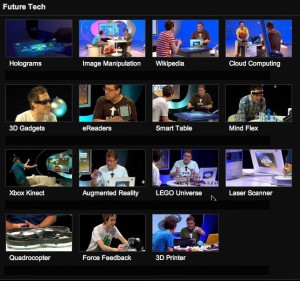
3d Printing, Haptics, Ardrone, 3d scanning, MMO Lego, AR, Kinect, Mind control, SMARt tables, eReaders, 3D cameras and glasses, Unity3d/evolver games dev, Cloud Computing, Wikipedia, Photoshop, Laser Holographic projection….
To come is Solar Flares, Opensim and the outside video we have now done indoor skydiving, indoor snowboarding, Racing simulators, science gadgets and planetarium.
So I have ended up on wikipedia and have over 20 TV records under my belt now. I have a showreel of sorts with its own page here and my new business cards say amongst the blurb TV Presenter. (I think that’s valid now isn’t it?)
When people ask what it is I do and what Feeding Edge does, I think this does all some up in “Taking a bite out of technology so you don’t have to”.
I think that because pushing things forward, thinking of the whole not just design not just tech but the social implications of it, but mashing in the fact that things should entertain and engage us as humans is my mission.
So what does next year bring? Well for me more of the same is the answer.
I am asked how I have time to do all the things I do. The answer is I don’t. Sometimes things have to slide a bit. Whilst many things seem diverse they are linked. I play games, looking at them for review, to spot trends, to see how things might be used in other gamification contexts and for enjoyment. Then I write about them, present about them and even build them. It’s all part of the flow. The same goes for the other emerging tech. If you are interesting in 3d virtual worlds, then naturally how to create 3d content, how to experience 3d content and how to use 3d environment to reach an audience becomes part of everyday life.
Then there is the social media side of things. I tweet, blog, share photos on flicker, put game achievements up on facebook and raptr. It is both a personal sharing of whats goidn on to those who need to know or are curious, but it is also a social experiment in how it feels to do these things and the impact it has on my life. Having that personal experience lets me share it with others and with companies and get them to the good part of this communication revolution rather than stagnating.
People I know often say to me they only understand 1/3 of my tweets. That is great as probably the 1/3 was for their benefit the other 2/3 for others. Mixing busines, social, tech and existence on one channel in 140 characters is still fascinating. It is a microcosm of the whole of what I do with Feeding Edge.
So to all my customers, partners, competitors, friends, mentors and fellow virtual world evangelists I say a huge thank you for all your support.
Right, back to it, now what was I do again?
Knowing who you know
Very often the naysayers of social media will point to the vacuous nature of connections online. Friend does not mean an actual friend etc. We are also restricted as human in how many people we can successfully know and stay in touch with. We are though in a position where we are able to share who we are and what we do, and make it available to anyone who finds it useful. We may all have a mental model of our relationships and who matters, who influences us and who we mentor in life. Social media has brought us the ability to visualise and data mine those relationships. (It has also allowed others/businesses etc to look at those and use them commercially).
Linkedin has started a project to show your professional links to people and it produces very organic looking social media graphs, this is my one from my profile connections
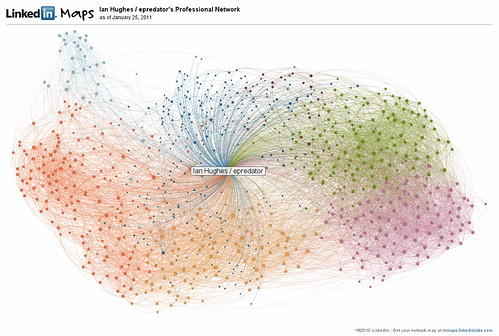
When you create it you also get to label the coloured groupings which are roughly people in certain types of network. I have lots of virtual world and tech people in my network both from my corporate career colleagues and from other places and a little spin out cloud of media people and one directly related to WImbledon.
Visualizing data like this and being able to navigate around it does start to inform and provide a check and balance for your mental model.
The application is available here
What’s the point of a tweetup?
This weekend we had a Southampton based tweetup as a christmas spin off off the occasionally Tuesday Tweetups that have been going on well over a year now.
Just as twitter, or any social networking online gets the odd guffaw from those who don’t use such services, the tweetup with physically meeting people is usually greeted with some derogatory comments about geeks getting together to tweet one another in a room.
As with all events they take some arranging, and commitment to turn up, with such a loose affiliation as twitter this may seem unlikely, however with both the efforts of @OzoneVibe and some quick thinking by @amandagolding to book the excellent Orange Rooms in Southmapton we all gathered, ate, drank and talked (not in that order).

However the tweetup is another form of social gathering, it is like popping into a local pub. (very often a tweetup is actually in a local pub anyway). The pub used to be the social hub of a community. Regulars and visitors mingling, and generally a mix of people from many walks of life. Of course a local pub clientele of old would probably have pretty much been people of a similar background, same schools, local firms etc. The world has changed quite a bit of course, demographics and people moving around more, vast changes to the employment and industrial makeup means that we mix and connect in different ways. Some would point out our web cliques on social media restrict our serendipitous meetings, and that can be the case just as in any social environment. . However I think the affordances this gives us to meet and listen to other people, friends of friends, colleagues of colleagues etc means if we are open to new conversations there are there to be had.
Saturdays tweetup was a case in point. Many of us hook up with people we already know online, friends, colleagues and people in the field we are interested in. However in that you also tend to bump into other people. In the case of this tweetup is happens to be a gathering of people in and around the Southampton area.
On going there you find that in a group of 30 or so people you will know a few personally, and a whole lot more more indirectly they had open conversations with the people you already know. It is those people who are quite often in a completely different sphere to you.
A prime example was that many of us techies were chatting away but we then got talking with a fellow tweeter and someone asked her how her pants were going. (Pants being colloquial word over here for Knickers).
That meant we needed to find out more as thats a pretty good ice breaker.
It turns out that @dellacunio from local manufacturing firm Who Made Your Pants
We got to talk a little before the music kicked in at the venue we were at and this is a brilliant workers cooperative social and ethical business.
They help provide training and jobs to help women who have not had the chances to work and and improve their qualifications.
The business cooperative and ethical actions it take have attracted positive attention from those in the lingerie business. Social enterprises are always interesting, the antithesis of the corporate world, but with real business pragmatics in place. They are founded based on ethics not profit, yet they still work and succeed. Maybe a lesson for corporate life there?
Yes this is a web based business, but it is certainly more about serendipity and choosing to connect with people on social media that led to this conversation, and hence this blog post.
Updated 13/12/2010 with this video of the organisation and the founder talking.
I got talking to all sorts of people, but not everyone there, so there is plenty more where this story came from I am sure.
Imperial Treet – Hospitals, Patients and SL
This week Dave Taylor/Davee Commerce and Robin Winter had a special on Treet.tv about lots of the virtual world projects in Second Life that Imperial College London have been up to. It is a great show to watch to see the variety of ways Dave has got Second Life working from public information, targeted patient experiments and doctor training.
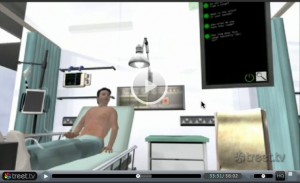
The doctor training and evaluation that appears around about 32 mins in Dave says. “This is where we have our virtual patients, and these patients are controlled by software actually outside of Second Life. That software has a knowledge of the patients physiology and condition.” He also explains there are 3 wards and 3 patients in each giving 9 levels of difficulty in scenario.
“We are using this to research how we can asses trainee doctors at different levels of training”. “We have tested about 60 doctors so far on this”.
I am glad this is out in the public as this has been part of the work I have been doing in SL. I can’t explain exactly what does what as its a private project but as Dave points out the patients and the interactions are controlled from outside of Second Life, my part in SL is the broker talking to that external model. I also ended up building the dynamic menus and handlers in world. The menu’s are based on the data coming back, and align to the correct place in world so they are designer friendly. This was built before the web on a prim existed, and we aimed to do everything in world. As you know handling text can be a problem in SL and variants of Fasttext and xy text came to rescue. Though rezzing a dynamic button and making it know what it is supposed to do is a non trivial task. This was also before HTTP in world servers were stable so SL is the controller asking the external software what to do next.
It has been a fascinating project, as has its follow on ones that have increased in complexity and in interactions. Making SL a component in a system not the sole piece of the project makes for a greater richness and flexibility. After all SL is not a database/data handling application.
What is great is that Robin, who is one of SL’s foremost designers (along with his other half) and has been for years(he built the original Dublin sim), is able to craft animations and objects and then trigger them into existence using our message protocol, after the external software model tells my broker code that its got some changes to display.
There are a few of us pushing the bondaries of data interchange with SL and also with opensim and other virtual worlds. I hope this helps people understand that we can do very complex integrated tasks using the best of a Virtual World and the best of a traditional server application. Integration is the key.
Unity3d growing – lets get schools in on this
A recent press release from Unity3d gave some impressive figures “Unity Technologies Surpasses 250K Developers Milestone and 35M Installs of Free Unity Web Player”
I am a big fan of Unity3d as you will have seen over the years and it is great to see the company doing so well. I do not think this success is purely technical, Unity3d is a great product but it has been the positive and open attitude of the company which if you ever talk to the CEO David Helgasson you will see why. It is a true startup come good.
The figures are impressive for the web plugin but the figures not shown, that are in fact even bigger is the fact that every iphone and droid can run Unity3d apps. Many of you will have even played or used some and possibly not even noticed.
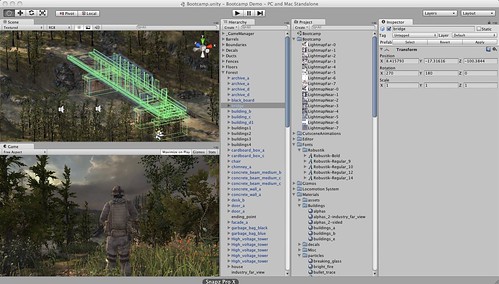
I expect to see Unity3d appear in more and more schools as part of both art and science lessons, that was partly my intention in showcasing it on The Cool Stuff Collective. This is a tool and an environment that has both great simplicity and the ability to get as complex as you want. Programming and graphic/sound integration is the ultimate UGC. We also have lots of ways to deploy and share that content.
It seems that a set of simple course material prefabs would make a great module in both infant and secondary education to help find the story tellers, game developers, artists and programmers of the future by letting kids just get on with it and create. There may be some real gems of ideas bubbling away out there don’t you think?
Having seen the willingness to create with my own kids, watching a 3 year old choose to paint the Kart in Mario Kart on the DS and decorate away, or seeing a 7 year old revel in 3d modelling with the haptic device we really should be pushing this future tech (not just Unity3d BTW) into schools, helping teachers understand the creative and learning potential.
I know lots of people are, I know there is lots of resistance to change too. However some of this is not massive capital expenditure (most schools seem to have computers). In just the same way as many of us solo entrepreneurs are able to punch above our human resources weight with access to amazingly accessible technology, so should the classroom.
It is then not a lesson about computing or tech but about creativity, expression as well as STEM.
Fingers crossed we can ride this wave. It is certainly one I want to pursue.
Anyone out there have good Unity3d educational related prefabs?
Real or Virtual its all the same thing
My friend and (sometime theatrical agent) Scotty pinged me to tell me about a bargain at blades and bows a predator mask for £20. It seemed to make a great deal of sense to buy this as a prop for some of presentations, as well as out of personal interest.
It has just arrived and it is pretty cool, and very heavy!

I have taken to using some physical props when I present at conferences, in particular some of the 3d printed items. Something solid and tangible reflected from something in the virtual environment helps break down the barrier between audience, screen and concept.
The predator mask is going to be one such prop. However it feeds directly into the discussion of representation of self online, into reputation and into knowing who someone is.
In SL my epredator avatar wears a predator mask. I often quote that “I wear a mask but don’t hide behind it” and that it indicates a lot more than a digital replica of my actual face in certain contexts.
Saying that with a ppt presentation picture of me in predator gear and leather jacket in Second Life I tend toblend to point out my RL leather jacket and the crossover of personal branding and a willingness to share who I am. The predator mask can be used to then show that there are cultural boundaries and social norms that differ from place to place. Wearing the mask would be seen as a slightly mad act, but showing it and choosing not to wear it in that context I think is a powerful message.
We talk often about real and virtual, there really is no such divide. We experience things, internalize them and try and make sense of them.The recent Horizon programme Seeing is Believing on BBC highlighted this more than ever. Demonstrating the NeuroPlasticity of the human brain and the combination of senses we use to predict what we are seeing. Including things like the McGurk Effect where are brains are unable to stop themselves altering what we hear based on what we see.
The point is virtual environments are real, not a total figment of imagination as they operate, run and we interact with them. A virtual environment tends to be experienced through the little glass window on our laptops which helps us deal with the containment of it. However its real people on the other end doing the same thing. Communicating and interacting with us and the environment. Whilst there is currently a line to be drawn the world around us is full of virtual structures and organizations. Does your company actually exist? Is that organization chart really real?
So I think we have shades of Real, all converted into the virtual experience we call memory.
All that because of a Predator mask? Well yes, though it is just really cool in its own right too 🙂
A lot of places to talk.
Very often there seems to be an assumption that we all live, talk or work in one place online and offline. That is of course not true. All these places whether text, image or virtual worlds are collection of places and venues that suit certain people at certain times. The brilliant infographic has just surfaced showing a whole load of places and why we use them.
The image is from http://www.theconversationprism.com/
If you relate this to the physical world, to offices and shops, houses, rooms in houses you will see that it really does not fit the human condition to have one and only one place to communicate, or one mode.
This may scare people, how do I learn all these places and ways of working, but in reality it is no different to learning that a grocers sell and works differently to a barbershop.
